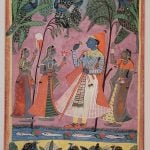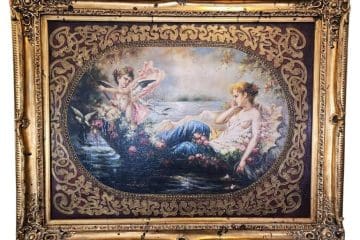19C Indian Miniature Painting of an Elephant
PRESENTING a VERY RARE19C Indian Miniature Painting of an Elephant.
Hand-painted on paper … Gouache.
Indian, probably Mewar, Rajasthan circa 1860-70.
It features a portrait of an Asian Elephant in ceremonial attire.
The Elephant is in a standing pose, wearing a green and red quilted cover, with white straps adorned with golden tassels and a gold bell.
His tusks are likewise decorated with gold bracelets. The hair on the end of his tail has been platted.
The scene is set against an ivory colored background and edged with cobalt blue with gold highlights.
The rear of the painting has Indian script that, unfortunately, we cannot translate. But we are confident that both the script and the paper show genuine signs of age, making us comfortable in deciding that this is most likely a Mid-19th Century miniature.
The detail of this painting is simply superb quality!
Initially, we thought this ‘might’ be a print because of the cross hatching effect on the elephants skin, but when we removed it from it’s frame for closer examination, we discovered that it is not a print and under a magnifier, it has no dots or pixels that would exist if it were a print. The cross hatching effect is the style of the painter and completely hand painted.
It is framed and under glass in a vintage brown and gold frame and has a tan matting. It was re-framed in Dallas in the late 20C by ‘Rust Picture Framing’ who operated in the late 1970’s at 3320 Kings Rd.
The Indian elephant (Elephas maximus indicus) is one of four extant recognised subspecies of the Asian elephant and native to mainland Asia.
In general, Asian elephants are smaller than African elephants and have the highest body point on the head. The tip of their trunk has one finger-like process. Their back is convex or level. Indian elephants reach a shoulder height of between 2 and 3.2 m (6.6 and 10.5 ft), weigh between 2,000 and 5,000 kg (4,400 and 11,000 lb), and have 19 pairs of ribs. Their skin colour is lighter than that of E. m. maximus with smaller patches of depigmentation, but darker than that of E. m. sumatranus. Females are usually smaller than males, and have short or no tusks.
Indian elephants have smaller ears, but relatively broader skulls and larger trunks than African elephants. Toes are large and broad. Unlike their African cousins, their abdomen is proportionate with their body weight but the African elephant has a large abdomen as compared to the skulls.
Link: https://en.wikipedia.org/wiki/Indian_elephant
It is elephants’ elevated standing in Indian culture that prevents them from being killed, even when they bring destruction to people and property. Over 80 percent of Indians are Hindus, and to members of the Hindu religion, the elephant is a sacred animal. Elephants are sacred animals to Hindus. It is the living incarnation of one of their most important gods: Ganesh, an elephant-headed deity who rides atop a tiny mouse.
There are many stories of Ganesh’s creation, but the best known say he is the son of Parvati, the Hindu goddess of the mountains and wife of the greatest god, Lord Shiva. One day, Parvati desired a guard as she took a bath, so she created Ganesh from dirt to stand watch. But the boy did his job too well; he refused to let Lord Shiva see his wife. Angry, Shiva cut off the boy’s head. To console his grieving wife, Shiva gave Ganesh the head of an elephant.
According to Hindu scholars, each part of the deity has a symbolic function. Ganesh’s head itself symbolizes the ability to acquire wisdom and knowledge, while his big ears bestow the patience to listen carefully. Ganesh’s small eyes can behold the future and recognize truth, while his long trunk is able to sniff out good and evil. His big belly symbolizes the ability to digest both the best and worst in life. The tiny mouse upon which Ganesh rides symbolizes the ability to move quickly and decisively.
“All obstacles, whatever they may be, will be rooted out by worshipping Ganesh,” promises an ancient Hindu text. Today, following Shiva’s command that anyone beginning a new undertaking worship Ganesh, Hindus often invoke the elephant god’s name at the beginning of worship, trips, and projects — such as the elephant taming adventure documented in The Elephant Men. Ganesh is also honored at the beginning of books, because he is said to have been a great scribe and patron of learning. He is depicted on many temples; some even keep stables of real elephants for ceremonial events. In south India, for instance, there is a fall festival called Dussehra that is famous for its parade of elephants decorated with paint and cloth.
Gouache (/ɡuˈɑːʃ, ɡwɑːʃ/; French: [ɡwaʃ]), body color, or opaque watercolor is a water-medium paint consisting of natural pigment, water, a binding agent (usually gum arabic or dextrin), and sometimes additional inert material. Gouache is designed to be opaque.
19C Indian Miniature Painting of an Elephant.
Provenance: From a Quality Dallas Estate.
Dimensions: In Frame: 14 x 14 in
Visible Image Size: 5.75 x 5.75 in
Condition: Very Good original condition. The detail and colors are still very vibrant. Some minor scratches to the frame.
SALE PRICE NOW: $1,400


























